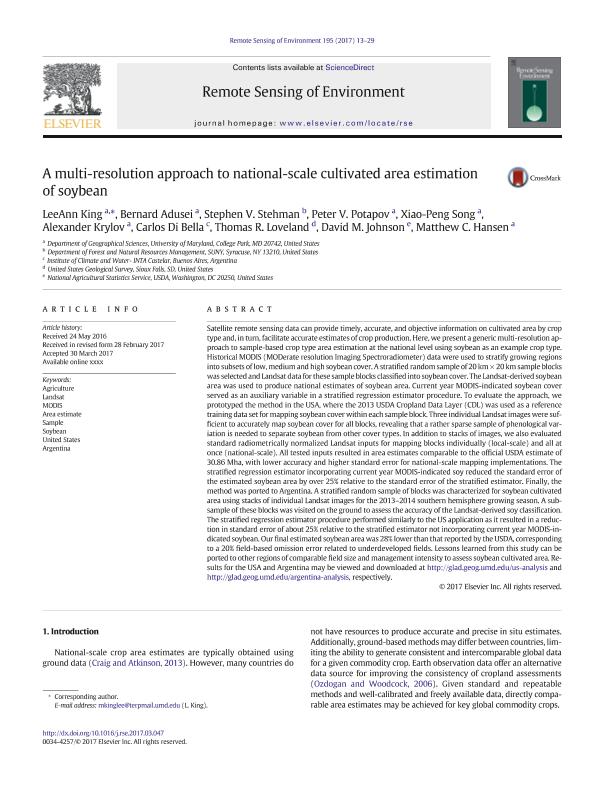Artículo
A multi-resolution approach to national-scale cultivated area estimation of soybean
King, LeeAnn; Adusei, Bernard; Stehman, Stephen V.; Potapov, Peter V.; Song, Xiao Peng; Krylov, Alexander; Di Bella, Carlos Marcelo ; Loveland, Thomas R.; Johnson, David M.; Hansen, Matthew C.
; Loveland, Thomas R.; Johnson, David M.; Hansen, Matthew C.
 ; Loveland, Thomas R.; Johnson, David M.; Hansen, Matthew C.
; Loveland, Thomas R.; Johnson, David M.; Hansen, Matthew C.
Fecha de publicación:
06/2017
Editorial:
Elsevier Science Inc
Revista:
Remote Sensing of Environment
ISSN:
0034-4257
Idioma:
Inglés
Tipo de recurso:
Artículo publicado
Clasificación temática:
Resumen
Satellite remote sensing data can provide timely, accurate, and objective information on cultivated area by crop type and, in turn, facilitate accurate estimates of crop production. Here, we present a generic multi-resolution approach to sample-based crop type area estimation at the national level using soybean as an example crop type. Historical MODIS (MODerate resolution Imaging Spectroradiometer) data were used to stratify growing regions into subsets of low, medium and high soybean cover. A stratified random sample of 20 km × 20 km sample blocks was selected and Landsat data for these sample blocks classified into soybean cover. The Landsat-derived soybean area was used to produce national estimates of soybean area. Current year MODIS-indicated soybean cover served as an auxiliary variable in a stratified regression estimator procedure. To evaluate the approach, we prototyped the method in the USA, where the 2013 USDA Cropland Data Layer (CDL) was used as a reference training data set for mapping soybean cover within each sample block. Three individual Landsat images were sufficient to accurately map soybean cover for all blocks, revealing that a rather sparse sample of phenological variation is needed to separate soybean from other cover types. In addition to stacks of images, we also evaluated standard radiometrically normalized Landsat inputs for mapping blocks individually (local-scale) and all at once (national-scale). All tested inputs resulted in area estimates comparable to the official USDA estimate of 30.86 Mha, with lower accuracy and higher standard error for national-scale mapping implementations. The stratified regression estimator incorporating current year MODIS-indicated soy reduced the standard error of the estimated soybean area by over 25% relative to the standard error of the stratified estimator. Finally, the method was ported to Argentina. A stratified random sample of blocks was characterized for soybean cultivated area using stacks of individual Landsat images for the 2013–2014 southern hemisphere growing season. A sub-sample of these blocks was visited on the ground to assess the accuracy of the Landsat-derived soy classification. The stratified regression estimator procedure performed similarly to the US application as it resulted in a reduction in standard error of about 25% relative to the stratified estimator not incorporating current year MODIS-indicated soybean. Our final estimated soybean area was 28% lower than that reported by the USDA, corresponding to a 20% field-based omission error related to underdeveloped fields. Lessons learned from this study can be ported to other regions of comparable field size and management intensity to assess soybean cultivated area. Results for the USA and Argentina may be viewed and downloaded at http://glad.geog.umd.edu/us-analysis and http://glad.geog.umd.edu/argentina-analysis, respectively.
Palabras clave:
Agriculture
,
Area Estimate
,
Argentina
,
Landsat
,
Modis
,
Sample
,
Soybean
,
United States
Archivos asociados
Licencia
Identificadores
Colecciones
Articulos(SEDE CENTRAL)
Articulos de SEDE CENTRAL
Articulos de SEDE CENTRAL
Citación
King, LeeAnn; Adusei, Bernard; Stehman, Stephen V.; Potapov, Peter V.; Song, Xiao Peng; et al.; A multi-resolution approach to national-scale cultivated area estimation of soybean; Elsevier Science Inc; Remote Sensing of Environment; 195; 6-2017; 13-29
Compartir
Altmétricas



